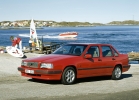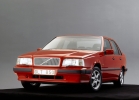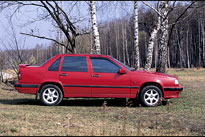Test drive Volvo 850 1992 - 1997 sedan
The facets of the image
Volvo 850 will warm his owner, but freeze his walletIn Russia, Swedish cars have always respected. They are considered not only exclusively reliable, but also, very important, perfectly adapted for operation in a cold winter. In the secondary market, one of the most popular was the Volvo 850 model.
The Volvo company first introduced a car with an index of 850 back in 1991, and stopped releasing it in 1996. But this does not mean that the model was bad and the Swedes were forced to remove it from production. Just the opposite - the Volvo 850 design is very successful. Just in 1996, a deep modernization of the car was carried out, after which it began to be called the Volvo S70/V70. At the same time, the 850 model itself has two generations - in 1993, a small restyling took place (outwardly updated cars can be recognized by new rear lights that became not so square, and a small jumper under the license plate). But the most important cars made after 1993 became more reliable, devoid of many childhood diseases inherent in earlier samples. Therefore, it is recommended to buy Volvo 850 precisely 1993-1996.
Some Volvo 850 owners, made before 1995, can greatly upset the air conditioner, more precisely, its evaporator. However, we must immediately say that the breakdown of this expensive node occurs only if the driver does not listen to the recommendations of repair masters. And they advise installing a salon ventilation filter in the machine, which costs $ 40-60 (until 1995 it was listed in the list of options and is not found in all cars). In the absence of a filter on the evaporator, moisture and dirt inevitably accumulate, which in a couple of years are able to destroy both the mechanism itself and the air conditioner tube (the evaporator costs $ 420, and the repair will pull more than $ 300, since to replace it, it is necessary to dismantle the front panel in the cabin, plus plus Another $ 50 will go to refuel the air conditioner). Over time, the kondeya radiator ($ 200 per non -original) may break, which is located in front of the radiator of the engine cooling system (for longer operation it must be cleaned a couple of times a year).
Charged suitcases
Volvo 850 differs from many cars in that it had exclusively 5-cylinder engines under its hood. Among them, the most modest was a 2-liter unit with a capacity of 129 hp. Such machines come across in our market quite rarely, as customers usually chose faster options. But it should be noted that even a model with a 2.0 liter engine cannot be called turtles - their maximum speed is 195 km/h.
More common engines with a volume of 2.4 liters (more precisely, 2435 cm3), which Volvo called 2.5-liter. Such motors can be both with four valves on a cylinder (170 hp), and with two (144 hp).
In 1996, VOLVO 850 Bi-Fuel versions appeared, working both on gasoline and gas. Machines made in 1996 (the last, when the Volvo 850 was produced) can also have a 2.4-liter engine with a low-pressure turbine (193 hp), which was put on modifications with a full-wheel drive system. This motor makes a rather heavy and outwardly clumsy Volvo 850 very dynamic, and the advantage of a low turbine is that the maximum torque at 270 nm develops at 1800 rpm (for comparison: a 170-horsepower engine produces its 220 nm only at 4700 rpm).
But Volvo has not limited it to this. For hot guys, the Swedish company produced two charged versions at once, equipped with a 2.3 liter engine with a high -pressure turbine. One of them is called T5 (225 hp). The second bears a more formidable name Volvo 850R (or 850 T5-R). These growling cars differ from the rest already 250 horses under the hood, other aerodynamic body kit, wheels with low -profile rubber, hard sports suspension, other brakes, etc.
All this, of course, will affect the cost of possible repair. And you, be sure, will have to be carried out, because they drove it to Volvo 850R. Yes, even like - the acceleration time 0-100 km/h is only 6.7 s. Spare parts for 850R are like an expensive one, because only the original is found on sale. That is why those who wish to have a powerful Volvo often hear advice to modify their ardor a little and turn the gaze to a slightly calmer (but also very fast) Volvo T5. Many details from ordinary machines, including non -original ones, are already suitable for it.
Twist with the calculation
Without exception, all 5 -cylinder engines are recognized as reliable masters - with proper maintenance, they are able to serve more than 500 thousand km. Then you usually have to repair the cylinder head with the replacement of rings, seals, etc. (along with work, such an operation will cost $ 2000). But such repairs are an extreme case. If the machine starts to eat oil, it is usually enough to change the oil -removable caps. In some garages, this can be done for $ 500, but serious services offer to immediately remove the block head and carry out much more serious work over the motor (in this case, the costs will amount to about $ 1300, but the masters will give a guarantee). Approximately every 100-150 thousand km of replacement requires the rear oil seal. But there is nothing to be afraid of-the work and spare parts will be pulled out of the wallet no more than $ 180-200 (it is worth noting that in a bad engine, the oil seal can fail and after 20-30 thousand km of run).
When the hydraulic compensators are knocking, you need to look - if after warming up the engine the clatter disappears, then it is not necessary to touch the motor yet (it will be enough to fill the oil thoroughly). But if the sound is constant, then the power unit experiences oil starvation. If the reason lies in poor lubrication or a clogged filter (it must only be taken in the original version), you can limit yourself to small expenses - the main thing is to eliminate the cause of starvation as quickly as possible. In a neglected situation, serious repairs will be required (by the way, the work on replacing hydraulic compensators costs $ 250, and the set of parts of $ 200-400 depending on the engine). Another characteristic problem of Volvo engines is the need to change the two supports of the four engine every 3-4 years. Usually the right and upper pillows wear out. The first costs $ 50 - for non -original and $ 100 - for proprietary, and the second - $ 12 and $ 15, respectively ($ 10-15).
During the operation of the Volvo 850 in Russia, you need to remember that the timing belt needs to be changed every 75 thousand km. This operation is not cheap - replacing the required set of belts and rollers in total costs $ 460. But you should not save on the belt (you need to buy original parts), since its cliff leads to the repair of the cylinder head. It is best to change the oil with an air filter more often - for longer operation of the motor, it is advisable to do this every 10 thousand km (according to the instructions, an air filter worth $ 30 must be replaced after 30 thousand km).
You can often hear that turbocharged engines have a lower resource compared to atmospheric units. However, not all Volvo repair masters share this point of view. Charged motors themselves are very reliable, and the turbine with competent operation and regular oil change (for such units is extremely important), more than 200 thousand km are capable of working. True, it should be noted that if at least a couple of times do not let the turbine cool and immediately turn off the motor after an incendiary ride, the boost system will require a very expensive repair.
We also need to mention the fact that under the hood of Volvo 850 you can also find a 2.5 -liter diesel with a capacity of 140 hp, developed by the Volkswagen concern. This motor is completely good, and in many cases it only requires oil replacement every 7 thousand km.
Everybody ruins!
As already mentioned, the Volvo 850 may have a full-wheel drive system, which was installed on cars with a 2.4-liter engine with a turbocharged (other front-wheel drive). According to VOLVO 850 AWD drivers, they are very confident in winter on the road, but there are no complaints about the work of the all -wheel drive system (by the way, in standard situations 95% of the torque is transmitted to the front wheels). That's perhaps the cost of maintenance of the rear suspension is much larger, because most spare parts for such machines are only original.
VOLVO 850 gearboxes are reliable. There are only small claims to the mechanics of the first years of release (sometimes transfers are poorly included). Moreover, in this case, the owners often prefer not to repair the box, but to buy a recovered at the Volvo factory, or used from a showdown.
The clutch service life often depends on the driver’s driving style, but in most cases 100-150 thousand km can withstand (of course, on charged versions, the clutch has to be changed much more often). The cost of the kit is about $ 180-200 (for 850T and 850R - more than $ 350). The automatic machine for Volvo 850 is Japanese. It itself is very reliable and is able to work even longer than the engine itself. But sometimes the automatic transmission breaks due to the constructive features of the car. It turns out that the radiator of automatic transmission is located inside the engine radiator. And if for some reason the radiator of the box is even slightly depressurized, the antifreeze from the motor will begin to get into the transmission and mix with the ATF liquid. As a result, the lubricant of the box will gradually deteriorate, and the consequences of this may turn out to be the most terrible (by the way, it is better to change the lubricant in the KP every 30-40 thousand km).
The completely independent Volvo 850 suspension is quite comfortable, and even the car copes well with more or less large pits. And the controllability of the 850th model is good-this is the merit of the rear suspension with the Delta-Link system, which allows the rear wheels to steer. And, by the way, the reliability of the chassis also pleases the owners of Swedish cars. But buyers of used Volvo 850 should know that by 150-200 thousand km of run, most likely the back suspension will require a particular repair. Usually you need to change the silent blocks and the upper supports of the shock absorbers (on the machines of the last years, the supports have become more reliable). Moreover, the replacement of two of the four silent blocks takes a lot of time, since you have to disassemble the rear axle! The price of the installation of new parts is $ 200, but the cost of spare parts must be added to these costs. So, a pair of so-called small silent blocks costs $ 125, and two large ones-at $ 300-350!
In the front suspension, it is periodically necessary to change the upper supports of the shock absorber. And, I admit, shock absorbers themselves could be more reliable. And so with active ride, owners buy new ones after 50 thousand km. On cars until 1994, the ball support went separately from the lever. But then the Swedes decided to strengthen the reliability of the structure and made a ball one with a lever. To be honest, it did not help much, but the cost of spare parts increased from $ 30 to $ 120 (per non -original).
When buying a car, you must definitely look at the steering rack, which often leaks. It is important to find out in which place the oil seal was leaked. If at the top, the repair will cost about $ 80. If the steering rack flows from the sides, then you often need to order a new element assembly! And this is almost $ 700. Therefore, many are looking for a rail at a showdown for $ 150-200. Although there are services that are ready to repair the rail for $ 200, but in this case it should not have a wear of mechanical parts or corrosion (now such details are found infrequently).
Volvo 850 is the first serious step of the Swedish brand to change the image of their cars. The 850th model turned out to be quite successful, but in the first years of production it still suffered from childhood diseases (which is why it is better to buy cars after restyling). During the operation of the Volvo 850, you need to remember that this car has a rather complex design that requires qualified (and expensive) maintenance. So, the overhead of the chassis for the Volvo 850 costs about two to three times more than, for example, for the Volvo 700 or 900th series.
EXCURSION
In 1966, Volvo introduced a new 4-door sedan under index 144. Volvo 140th series attracted customers both design and its security systems. In those days, few people thought about security, and they even chuckled over Volvo for the fact that the company began to install belts on its cars to tie itself to a chair. However, life showed that the Swedish engineers were absolutely right.
The Volvo of the 140th series was released not only in the 4-, but also in the 2-door version (model 142), as well as as a station wagon (model 145). In 1968, the Volvo 164 car was shown. In principle, this is the same 144th sedan, but in a more chic configuration with a 6-cylinder engine.
In 1974, a new model was presented - Volvo 240 - a deep modernization of the Volvo 140th series. This car was also produced with 4- and 6-cylinder engines. The Volvo of the 200th series has undergone several modernizations that allowed the car to stand on the conveyor until 1992!
But in 1991, a presentation of a completely new car under the name Volvo 850 was held - a front -wheel drive model with a 5 -cylinder engine and completely independent pendants (and the rear had the stimulus effect). Initially, the GLT version with a 2.4-liter 20-valve engine with a capacity of 170 hp entered the market, but in 1992 a cheaper Gle modification appeared with the same engine in volume, in the design of which there were already 10 valves (144 liters .With.).
In 1993, a station wagon was shown. In the same year, a charged version of the Volvo 850 T5 appeared. And at the end of 1993, updated cars with a slightly changed appearance were on sale. Also in 1994, the Swedes began to make Volvo 850 R with a 250 hp engine. In 1996, the 850th began to install a 2.5 liter diesel engine. Then the list of basic equipment also expanded. In particular, all the machine without exception were equipped with lateral airbags.
In the second half of 1996, the S70/V70 models appeared, although the Volvo 850 was released for several more months. Volvo S70/V70 (sedan and station wagon, respectively) were only a deep modernization of the model. However, in addition to other appearance, these machines also received a number of new engines.
In 2000, Volvo released two completely new models at once, which replaced the S70/V70. The sedan was called S60, and the station wagon retained the old name - V70. Volvo S60 and V70 are now equipped with various engines, including a 2.5-liter turbocharged unit with a capacity of 300 hp. (version S60 R).
Denis Smolyanov
Source: Mkobil magazine [01/17/2005]






